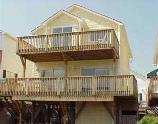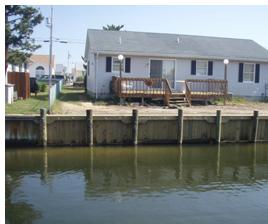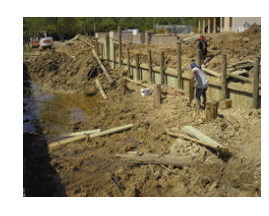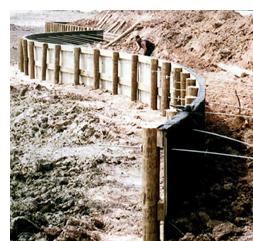Bulkhead Inspections |
||||||||||||||||
 |
||||||||||||||||
 |
||||||||||||||||
.. |
||||||||||||||||
Bulkhead Inspections |
||||||||||||||||
 |
||||||||||||||||
One of the largest problems with bulkhead systems is erosion of the backfill area. As the backfill begins to erode, the granular surface is affected, as is the drainage. The increase in hydrostatic pressure, coupled with the lateral forces of the earth itself, tend to push the bulkhead over or significantly warp it. Secondly, wood bulkheads rot out and aluminum ones corrode out especially where back-filled with concrete rip-rap or cementious sand. The major points in favor of these structures is that they can be attractive and protect property while they are functional. In some cases one has no choice on bulkheads which may be dictated by deed restictions or other authority having jurisdiction. Wood bulkheads should be used only in harbors or areas not prone to wave action as wave and water action on the front side of the bulkhead area creates a number of problems including but not limited to undermining the bulkhead. Bulkheads can be constructed from a variety of materials including concrete, wood, vinyl, steel and aluminum. Each material has its pros and cons. Wood for example may be the least expensive but may also not last as long due to marine organisms and decay. In addition marine organisms, corrosion and soil pH can damage materials in ways that may not be obvious unless destructive testing is made by the owner of the bulkhead which would include laboratory analysis all of which is beyond the bounds of a visual inspection. Marine borers are little organisms that love to eat wood, and they are divided into two groups: 1. Mollusca: The mollusca are animals with a shell, like oysters or clams. 2. Crustacea: T There are also wood-boring insects and worms such as the teredo (Phylum: Mollusca) which is a marine bivalve mollusk similar to an elognated clam. Its two shells, enclosing only the front end of the body, function as a tool, rather than a protective covering; their ridged and roughened surfaces are used for boring. The common shipworm of the Atlantic Ocean, Teredo navalis, may grow up to 2 ft (60 cm) long, although its shells remain only 12 in. (12 mm) long. Shipworms feed on wood particles and minute organisms. They do enormous damage to piers and ships and were death to the wooden ships that cruised the oceans of the world. Wood is perhaps historically the most popular choice of material in residential marine bulkhead construction. A wood pile/wale/sheet system is a common bulkhead configuration. In some cases, the bulkhead may be damaged due to loads in excess of what it was originally designed to withstand. For example, the homeowners may have installed a swimming pool after the bulkheading. Adding a pool may have damaged the tie-backs as well and the only way of knowing is to dig up the yard. It would be best if inspections are performed at certain times of the year (typically winter - November/December to February) when winds tend to push the water from canals and at low tide exposing the earth. Portions of bulkheads underwater or buried in the earth are naturally, not able to be seen or inspected. up to $289.00 local |
||||||||||||||||
Bulkhead Inspection If it can be photgraphed it can be visually inspected. The best time to inspect bulkheads are between December and late February as the wind is basically out of the north to lower the depth of the water. |
||||||||||||||||
Public Safety Bulkheads or shorelines in unincorporated Galveston, Brazoria or Chambers Counties are likely to endanger persons or property: 1. the owner of the structure, the owner's agent, or the owner or occupant of the property on which the structure is located to repair, remove, or demolish the structure or the part of the structure within a specified time; or (2) repair, remove, or demolish the structure or the part of the structure at the expense of the authority having jursidiction on behalf of the owner of the structure or the owner of the property on which the structure is located and assess the repair, removal, or demolition expenses on the property on which the structure was located. (b) The authority having jurisdiction (AHJ) shall provide by order for: (1) the assessment of repair, removal, or demolition expenses incurred under Subsection (a)(2); (2) a method of giving notice of the assessment; and (3) a method of recovering the expenses. (c) Promptly after the assessment, the AHJ must file for record, in recordable form in the office of the county clerk in which the property is located, a written notice of the imposition of a lien, if any, that is imposed on the property. September 1, 2011 |
||||||||||||||||
SUPRA
Access

 he crustacean are in the same family as lobsters and crabs
he crustacean are in the same family as lobsters and crabs With proper treatment the service life for a wood bulkhead might be 20 years (subjective) to minimize marine borer impact. CCA is Pressure Treated lumber or Pilings that have been pressure-impregnated with a preservative which makes the wood resistant to attack by marine borers that cause wood to decay. However, treated lumber is not immune fom decay and will eventually rot in water. Any wood preservative
With proper treatment the service life for a wood bulkhead might be 20 years (subjective) to minimize marine borer impact. CCA is Pressure Treated lumber or Pilings that have been pressure-impregnated with a preservative which makes the wood resistant to attack by marine borers that cause wood to decay. However, treated lumber is not immune fom decay and will eventually rot in water. Any wood preservative 